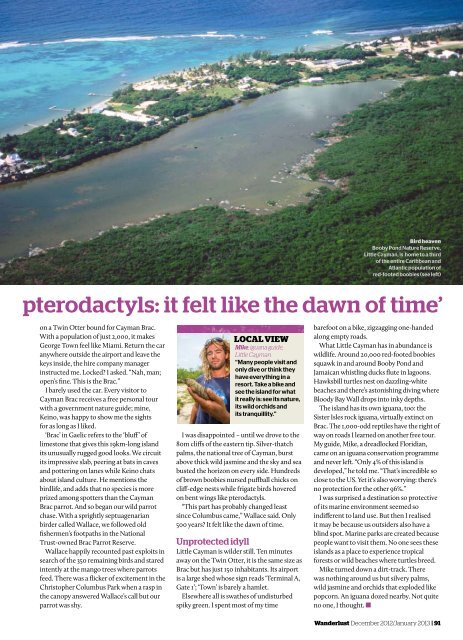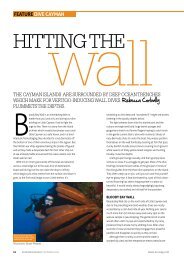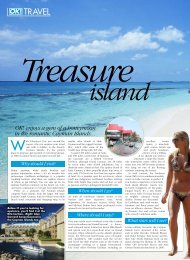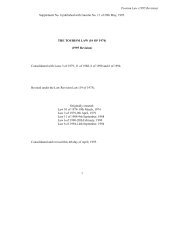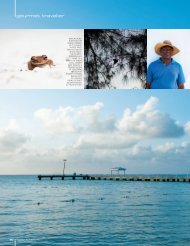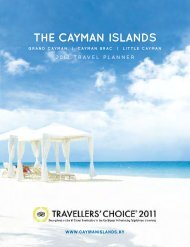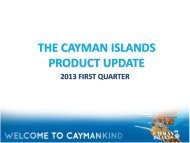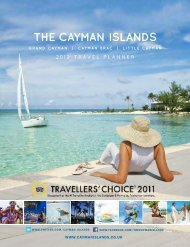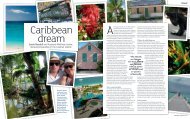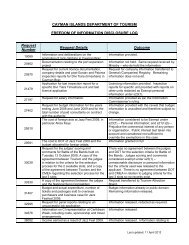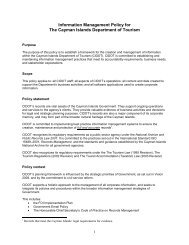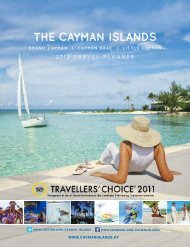You also want an ePaper? Increase the reach of your titles
YUMPU automatically turns print PDFs into web optimized ePapers that Google loves.
pterodactyls: it felt like the dawn of time’<br />
on a Twin Otter bound for <strong>Cayman</strong> Brac.<br />
With a population of just 2,000, it makes<br />
George Town feel like Miami. Return the car<br />
anywhere outside the airport and leave the<br />
keys inside, the hire company manager<br />
instructed me. Locked? I asked. “Nah, man;<br />
open’s fine. This is the Brac.”<br />
I barely used the car. Every visitor to<br />
<strong>Cayman</strong> Brac receives a free personal tour<br />
with a government nature guide; mine,<br />
Keino, was happy to show me the sights<br />
for as long as I liked.<br />
‘Brac’ in Gaelic refers to the ‘bluff’ of<br />
limestone that gives this 19km-long island<br />
its unusually rugged good looks. We circuit<br />
its impressive slab, peering at bats in caves<br />
and pottering on lanes while Keino chats<br />
about island culture. He mentions the<br />
birdlife, and adds that no species is more<br />
prized among spotters than the <strong>Cayman</strong><br />
Brac parrot. And so began our wild parrot<br />
chase. With a sprightly septuagenarian<br />
birder called Wallace, we followed old<br />
fishermen’s footpaths in the National<br />
Trust-owned Brac Parrot Reserve.<br />
Wallace happily recounted past exploits in<br />
search of the 350 remaining birds and stared<br />
intently at the mango trees where parrots<br />
feed. There was a flicker of excitement in the<br />
Christopher Columbus Park when a rasp in<br />
the canopy answered Wallace’s call but our<br />
parrot was shy.<br />
Local view<br />
Mike, iguana guide,<br />
Little <strong>Cayman</strong><br />
“Many people visit and<br />
only dive or think they<br />
have everything in a<br />
resort. Take a bike and<br />
see the island for what<br />
it really is: see its nature,<br />
its wild orchids and<br />
its tranquillity.”<br />
I was disappointed – until we drove to the<br />
80m cliffs of the eastern tip. Silver-thatch<br />
palms, the national tree of <strong>Cayman</strong>, burst<br />
above thick wild jasmine and the sky and sea<br />
busted the horizon on every side. Hundreds<br />
of brown boobies nursed puffball chicks on<br />
cliff-edge nests while frigate birds hovered<br />
on bent wings like pterodactyls.<br />
“This part has probably changed least<br />
since Columbus came,” Wallace said. Only<br />
500 years? It felt like the dawn of time.<br />
Unprotected idyll<br />
Little <strong>Cayman</strong> is wilder still. Ten minutes<br />
away on the Twin Otter, it is the same size as<br />
Brac but has just 150 inhabitants. Its airport<br />
is a large shed whose sign reads ‘Terminal A,<br />
Gate 1’; ‘Town’ is barely a hamlet.<br />
Elsewhere all is swathes of undisturbed<br />
spiky green. I spent most of my time<br />
Bird heaven<br />
Booby Pond Nature Reserve,<br />
Little <strong>Cayman</strong>, is home to a third<br />
of the entire Caribbean and<br />
Atlantic population of<br />
red-footed boobies (see left)<br />
barefoot on a bike, zigzagging one-handed<br />
along empty roads.<br />
What Little <strong>Cayman</strong> has in abundance is<br />
wildlife. Around 20,000 red-footed boobies<br />
squawk in and around Booby Pond and<br />
Jamaican whistling ducks flute in lagoons.<br />
Hawksbill turtles nest on dazzling-white<br />
beaches and there’s astonishing diving where<br />
Bloody Bay Wall drops into inky depths.<br />
The island has its own iguana, too: the<br />
Sister Isles rock iguana, virtually extinct on<br />
Brac. The 1,000-odd reptiles have the right of<br />
way on roads I learned on another free tour.<br />
My guide, Mike, a dreadlocked Floridian,<br />
came on an iguana conservation programme<br />
and never left. “Only 4% of this island is<br />
developed,” he told me. “That’s incredible so<br />
close to the US. Yet it’s also worrying: there’s<br />
no protection for the other 96%.”<br />
I was surprised a destination so protective<br />
of its marine environment seemed so<br />
indifferent to land use. But then I realised<br />
it may be because us outsiders also have a<br />
blind spot. Marine parks are created because<br />
people want to visit them. No one sees these<br />
islands as a place to experience tropical<br />
forests or wild beaches where turtles breed.<br />
Mike turned down a dirt-track. There<br />
was nothing around us but silvery palms,<br />
wild jasmine and orchids that exploded like<br />
popcorn. An iguana dozed nearby. Not quite<br />
no one, I thought. ■<br />
Wanderlust December 2012/January 2013 | 91


